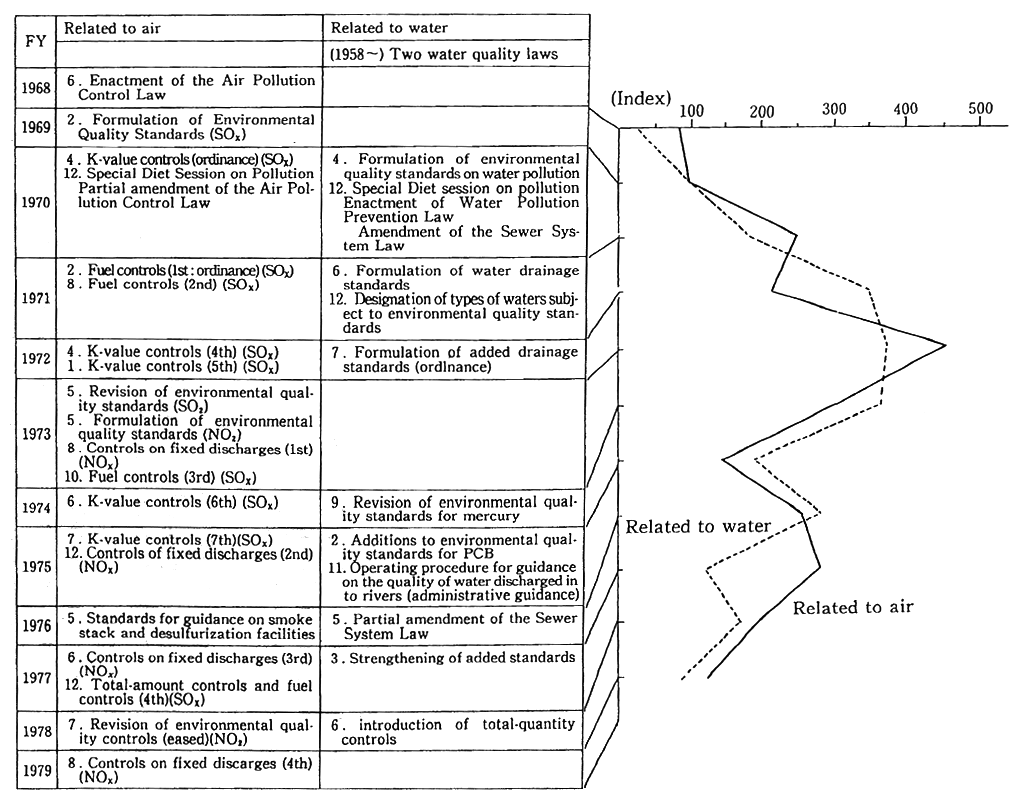Quality of the Environment in Japan 1992
Fig. 2-2-12 Progress of Measures Against Farmland Sell Pollution (Break-down of Areas with Monitored Values Higher Than Standard Values)
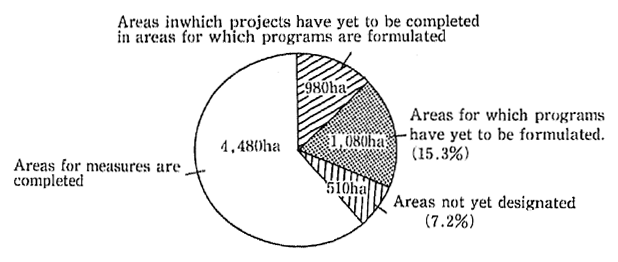
Source Environment Agency
Environmental pollution and destruction of nature which acceler-ated and intensified with the rapid pace of economic growth in Japan, brought grave impacts on the natural ecological system as well as on health of human beings. For example, in the Seto Inland Sea with its white sands and verdant pine trees, which is one of the leading scenic areas of the country, a considerable portion has been lost due to recla-mation and landfills which were carried out because of the advanta-geous location for industry. Before World War II, only about one to three sq. meters were filled up in a year, but in the past World War II years, this increased to about sq. kilometers per year, and so in the first 20 years after the war, landfills totaled about 163 sq. kilometers. (Fig. 2-2-13).
Fig. 2-2-13 Decreases in Natural Coasts of the Seto Inland Sea
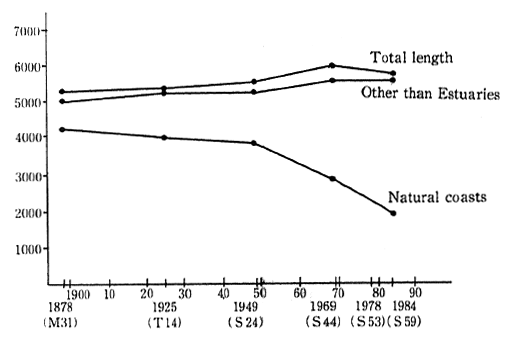
Source: Ministry of Construction's "Outline of the Seto Inland Sea" and the Environment Agency's survey
The total length of natural teaches and the size of tidelands where a rich ecological system exists and which supports the sea's productivity, declined to roughly half of what existed at the outset of the 20th century (Fig. 2-2-14).
Fig. 2-2-14 Decreases in Area of Tidelands and Increases in Area of Reclaimed Land
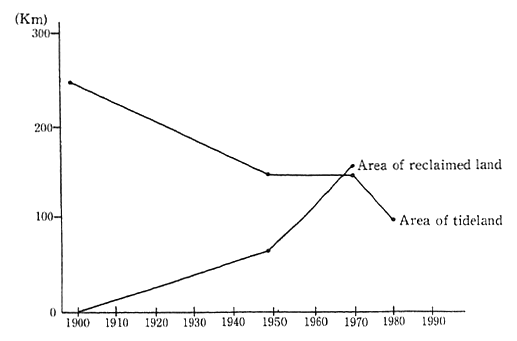
Source: Ministry of Construction's "Outline of the Seto Inland Sea" and the Environment Agency's survey
Since this kind of concentrated regional development was carried out in a basically enclosed sea, the number of cases of marine pollution and cases of red tide increased sharply during the 1960's, which, often caused big damage for the fisheries industry (Fig. 2-2-15). Also, there were instances where accidents at petroleum tanks on land led to leakage of crude oil. Also, while the Seto Inland Sea was famous for its scenic spots for sightseeing, after the period of rapid economic growth, the growth in the number of tourists who visited there became slower than that in the country as a whole.
Fig. 2-2-15 Number of Occurrences of Red Tide in the Seto

Source Fisheries Agency
As we can see here, in regional development efforts of that early period when there was little consideration given to the environment, various types of negative influences were created upon the environment, and so, based upon an understanding of this, it was decided to enact a special law which imposed strict limits on development of landfills, locating of plants and operating plants in the Seto Inland Sea.
Industrial pollution, which occurred on a drastic scale and inten-sity in the past and has been considerably improved compared with that in the 1960's, is still with us today, and it has not been solved complete-ly. Unless the necessary expenditures are made now, even greater costs in the form of damages to the global environment, and in the cost of measures to recover from thosedamages will result, which would be pushed onto the society at large and to the future generations. In not a few cases, these costs become far more expensive than the costs that the polluter failed to pay at the source. It is necessary to keep in mind how short-sighted economic activities aimed only at profit, which lack adequate consideration paid to the environmental aspects, can often result in the outbreak of industrial contamination, with huge damages, as the negative side of such economic activity. We need to make full use of this precious lesson in other countries as well as in Japan.
Table 2-2-2 Minamata Disease-Related Chronology (Excluding Items Related to niigata's Minainata Disease)

2-2-2 Reasons for Inadequate Consideration for the Environment
In the process of economic growth, Japan has undergone a number of unfortunate experiences where the sustainability of the social economy was undermined in the form of environmental pollution and destruction of nature. Why did such things occur? Let us look into the background of this question. For in order to create a sustainable society, we need to examine and change these factors and circumstances.
It can be said that the awareness of the Japanese people and business enterprises are generally high with regard to the protection of environment. According to the findings of a public opinion survey carried out by the Prime Minister's Office in 1990, 59.7% of the respon-dents said that "among all global problems, the global environment is the one that we should tackle with the highest priority" (Fig. 2-2-16).
Fig. 2-2-16 Awareness on Global Environmental Issues

Source: Prime Minister's Office
Also, according to the 1990 survey on people's preferences in living carried out by the Economic Planning Agency, 58.7% of the respon-dents responded that "we should make efforts to protect the natural resources and the environment even if it required us to reduce the rate of economic growth" (Fig. 2-2-17). The same survey investigated how people evaluated the relative importance of many items which are likely to he related to their livelihood in the future, both today and in the future. The item "free from pollution such as air pollution, noise, and offensive odors" ranked in the top ten, and furthermore, its ranking has been rising each year (Table 2-2-3).
While there is, therefore, active awareness regarding the protec-tion of the environment in general terms, when it comes to making a choice on concrete problems, the need to protect the environment is not necessarily given the higher priority.
Fig. 2-2-17 Survey on Awareness About Resources and Environment

A : Efforts should be made for the conservation of resource and the environment even if the economic growth rate has to go down.
B : The conservation of resources and the environment should be growth and the rise of the income standards.
Source; Economic Planing Agency
Table 2-2-3 Changes in Order of 'Pollution' as Important Matter for National Life

Source: Economic Planning Agency
According to the results of a 1980 survey carried out by the Environment Agency, those persons who have thrown away empty cans (who made up 27.8% of the total respondents), presented reasons such as: "There was no trash can box nearby," "I was riding in a car and I had a hard time dealing with it," "It was too much trouble taking it to a trash can or taking it home," and so on. Thus, there is a glaring absence of a sense of responsibility about protecting the environment here, and we can see that they begrudge the time and trouble to take the empty cans to a trash can box, etc., and that they give a higher priority to "convenience" over the environment.
We can see a similar tendency on the part of business enterprises. Generally speaking, the importance of protecting the environment is becoming widely recognized. According to a survey carried out by the Environment Agency in 1990, 65.2% of the business enterprises who responded had established an ongoing organization for dealing with environmental problems, and of this total, 56.8% had established such an organization in 1990 or later (Fig. 2-2-18). For business enterprises, it is not viable for them to engage in protection of the environment merely for the spirit. According to the "Survey on Enterprises Managing Capability" made by the Ministry of International Trade and Industry in 1990, the achievements that they aim at are "maximizing profits" and "maximizing sales volume" (Fig. 2-2-19). Also, according to the above survey by the Environment Agency, 62.7% of the business enterprises that responded stated that "We will bear the burden for the costs of protecting the environment as long as it does not impose a serious impact on business performance," while 7.5% of them declared that "it is a very grave issue, and we will bear the burden (such costs) regardless of the impact on the company's business performance, etc." (Fig. 2-2-20). Also, when we look at their awareness regarding bearing the costs for environmental protection in relation to their annual sales and ordinary profits, the results are as shown on Fig. 2-2-21. This means that for business enterprises, maximizing of their sales amounts and ordinary profits are the main objectives, and the cost for environmental protec-tion is considered to be important as long as it does not important impact negatively on business results.
Fig. 2-2-18 Establishment of Department in Charge of Environmental Issues in Private Companies
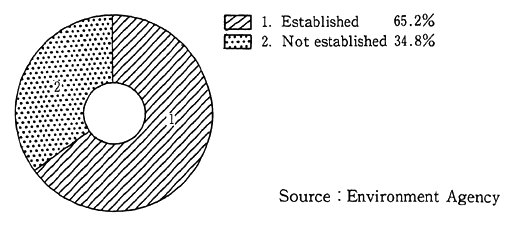
Source: Environment Agency
Fig. 2-2-19 Priority in Management Targets
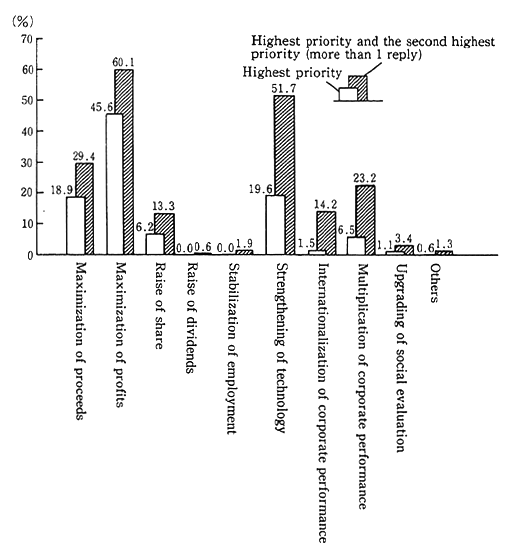
Source: Ministry of International Trade and Industry
Fig. 2-2-20 Determination Toward Environment-Related Expenses

Source: Environment Agency
Fig. 2-2-21 Degrees of Expenditure Not Producing Grave Adverse Impact on Management

Source: Environment Agency
Let us look at violations of the "Waste Disposal and Public Cleansing Law" which accounts for over 90% of the total number of arrests for pollution crimes, according to the data of the National Police Agency. We find that many of the motivating causes for illegal waste disposal were "to cut down the cost of disposal" and "to make money, from the outset," that is, for reasons based upon the desire for economic gain (Table 2-2-4).
Table 2-2-4 Total Number of Cases of Illegal Dumping of Industrial Wastes Broken Down by Motivation
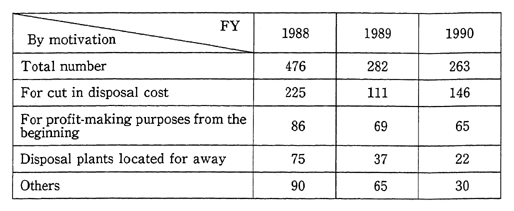
Source: National Police Agency
These data provide us with a good handle for reflecting about why it is difficult to give reasonable and correct attention and consider-ation to the environment. In situations where a choice between environ-ment protection and economic benefit is forced, there is a tendency to place more emphasis on economic benefit among both Japanese people and business enterprises. Under this kind of situation, it is feared that there has been a further deterioration of the environment. While the economic gains in the short term are clear, people tend to lose sight of the negative impact that their actions may bring on society overall and of the long-term point of view.
We produce various types of products in the course of production activities in the form of "goods," and consume them in our day-to-day living. Supply and demand for ordinary goods are adjusted in the market mechanism according to cost and price, and it is so arranged that they are not produced in excess (for any length of time).
However, environmental resources have a character that differs from the production elements, and for this reason, there are difficulties for realization of efficient allocation of resources by the market.
Let us take the Earth's atmosphere as an example. Unless there are special controls imposed, we use the atmosphere for production activity without any price and discharge pollutants into the air, And no one can be excluded from this activity. For example, even if discharge volumes of nitrogen oxides and other pollutants are to increase due to the increase in industrial plants and automobiles, it is not the situation that people will not be able to use the atmosphere unless individual persons reduce the discharge volumes of pollutants. Generally speaking, people and business enterprises do not bear the cost for the use of environmental resources. For this reason, environmental resources tend to be consumed excessively. However, the environment cannot accept and absorb pollutants limitlessly, and so, the problem of environmental pollution is created. It is a phenomenon which is described as the failure of the market and external non-economy.
In this way, if the use of environmental resources is left to free economic activity, then the environment is not protected, and pollution becomes rampant. Thus, it is necessary to instill the motive for environ-mental protection within all aspects of daily activity. Educating the public consciousness to the responsibility that we all must bear in utilization of environment through environmental education and enlightenment activity; is an indispensable means. However, if we are dependent on such means alone, we are not confident of certain success. As long as there are no disadvantages and penalties involved in deliber-ately ignoring considerations to the environment, economic gains are generated and environmental considerations are ignored. This immedi-ately creates an imbalance with those who give adequate attention to the environment in an honest manner.
In tackling the work of protecting the global environment, it is indispensable to develop social arrangements which promotes motivat-ing people and business enterprises to give adequate attention to the environment. Broadly speaking, such social arrangements will need to include the following types of policies as components: Education which heightens the public consciousness about the need for protecting the environment, a system of social and economic inducements which make activities that undermine the environment disadvantageous, and make activities that benefit the environment advantageous, and regulations and laws which restrict (or ban) specific activities that harm the envi-ronment. The administration of environment policy developed through such policy measures. Without policies that are based upon the perspec-tive of society's public interest, environmental protection will be diffi-cult to achieve. Thus, it is necessary to discuss these issues even more broadly among the people, and aggressively devise measures that are needed.
In particular, when we are trying to secure and preserve the blessings of the environment in the long-term, wise and far-sighted policies are absolutely essential. This is because in order to confidently predict the future, we need scientific forecasts. Also, it is future genera-tions who will suffer from the deterioration of the environment, and who do not have any measures to appeal it at the present time.
The same point can be made about global environment problems such as global warming and environmental destruction. For example, if only a certain group of countries carry out measures to cut emissions of carbon dioxide, etc., in order to prevent global warming, the benefits are not enjoyed by just those countries. Rather, the benefits become disper-sed and flow out to the world as a whole. Under these kinds of condi-tions, as long as the matter is left to the initiative of each country, then, there will be little incentive for tackling environmental protection actively. In particular, because states with their sovereign authority are the direct parties involved, there is as yet no organ which can coordinate and enforce policies in an unitary fashion. Unless there is voluntary coordination of policies, the global environment cannot be protected. Because of this situation, a number of international agreements and treaties have been signed in the past twenty years or so:
-"Convention on the Prevention of Marine Pollution by Dumping of Waste and Other Matter (referred to as the London Dumping Convention adopted in 1972)
-"Convention on International Trade in Endangered Species of Wild Fauna and Flora" (Washington Convention, adopted in 1973)
-"Montreal Protocol Regarding Substances That Deplete the Ozone Layer" (adopted on the basis of "Vienna Convention for Protection of the Ozone Layer" in 1987)
-And the Convention on Long-range Transboundary Air Pollution under the United Nations Economic Commission for Europe (ECE) (adopted in 1979).
In the Antarctic region which is not under any national sover-eignty, claims of sovereignty by various countries have been frozen under the Antarctic Treaty, and a number of international agreements have been signed by the signatories of the Antarctic Treaty, including the following: the agreement regarding measures to preserve the flora and fauna, the treaty for preservation of seals, and the treaty related to preservation of marine resources. Then, in October, 1991, "the protocol of the Antarctic Treaty for the protection of the environment" aimed at comprehensive environmental protection in the Antarctic region.
Thus, we see that the approach of placing management of the global environment beyond the framework of states, under international institutions and international agreements, is one key part of the founda-tion for tackling various kinds of problems related to the global environ-ment.
2-3 Achievements for Increasing Sustainability
Environmental problems are generated in the course of accumula-tion of different activities by people and business enterprises. In order for us to protect the environment, each member of the society must take an active stance for the solution of environmental problems near at hand, and actively implement concrete steps one by one. This is key. In this section, we will discuss how the national government, local govern-ments, business enterprises, and citizens have been tackling protection of the environment.
2-3-1 Building in considerations for the environment into the government administrative work
As we have seen in the previous section, activities and actions for the protection of the environment is not necessarily advantageous for individuals and business enterprises (from the short-term, narrow per-spective). And so, if we leave things only to the self-initiated efforts of people and business enterprises, it will be difficult to fully protect the environment. For this reason, in Japan, in our efforts to respond to the problem of pollution and environmental destruction, various regulative measures have been institutionalized. The efforts include promotion of development of technologies for pollution control measures, and support and financing of pollution control measures for factories. At the same time, the government administrative work for developing of social capital which contributes to environment protection (such as sewage and waste disposal facilities) has been actively promoted. An overview of the vicissitudes in the recent history of environment problems and the responses adopted and institutionalized is given in the following chart (Table 2-3-1). In the course of developing government administrative measures focused on emission controls, we can say that the measures for "flow" type of temporal environmental pollution have been im-proved and strengthened. However, measures to protect the environ-ment as a stock through dealing with cumulative contamination have been relatively few thus far.
Table 2-3-1 Environment-Related Developments
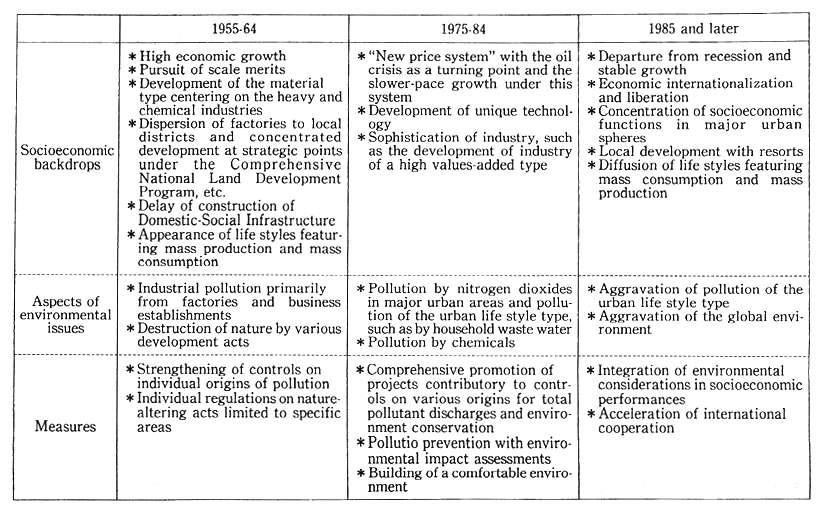
(1) Incorporating environmental considerations into the legal system and the government-administrative structure
In the course of the rapid economic growth in postwar Japan, environmental pollution accelerated which not only caused the living environment to deteriorate, but also led to grave consequences for the health and lives of the people as we can see in examples such as Yokkaichi asthma outbreak, Minamata Disease and Itai-Itai Disease. Irreparable damage and deformation of the country's nature took place as well. This destruction of the environment was caused mainly by stationary sources of pollutants such as factories and work places, that is, by different forms of industrial pollution. For this reason, the main method of dealing with the problem is to institute controls over the pollutants' sources for air and water pollution. When we look at the response on the national level, systems for control over pollutant sources for each industry was established within the ministry or agency which exercised supervision over that industry, for each type of manu-facturing. In relation to air pollution, the "Law Concerning Control of Emissions of Smoke and Soot" was passed in 1962 (implemented by the Ministry of Health and Welfare and by the Ministry of International Trade and Industry), and in relation to the problem of water pollution, the "Law Concerning Preservation of Water Quality in Public Waters" was passed in 1958 (implemented by the Economic Planning Agency) and the "Law Concerning Regulation of Industrial Effluent, etc." (im-plemented by the Ministries of Finance; Health and Welfare; Agricul-ture, Forestry, and Fisheries; International Trade and Industry; and Transport). However, it was still felt that these regulations should be harmonized with economic development. Moreover, the scope of control over industries was confined to those areas which suffered from very high levels of pollution. The measures, then, tended to chase after the problems after they occurred, and they were not necessarily adequate. To deal with these limitations, the "Basic Law for Environmental Pollution Control" was enacted in 1967 to define the scope of environ-ment pollution which must be addressed by government, to clarify the responsibilities of the national government, local governments and business enterprises, and to clearly formulate the basic principles that should govern the promotion of environmental measures, so as to be able to implement environment pollution measures in an comprehensive and unified manner. With the development of this kind of legal and administrative framework as the key occasion, various types of environ-mental pollution measures began to be drawn up, strengthened, and improved in a systematic manner.
In 1968. the "Air Pollution Control Law" was enacted with the aim of expanding the scope of areas to be controlled, and also brought automobile emissions under control (to be enforced by the Ministry of Health and Welfare, Ministry of International Trade and Industry, and Ministry of Transport). This was followed by the establishment of the "Noise Regulation Law" (to be enforced by the Ministry of Agriculture, Forestry, and Fisheries, the Ministry of International Trade and Indus-try, and the Ministry of Construction). And even in laws in related areas not directly related to the question of pollution prevention, (such as the "City Planning Law" enacted in 1968), provisions for environmental protection were incorporated, such as the stipulation that "city planning must be in accordance with the plans to prevent environment pollution."
In particular, in the 64th Session of the National Diet in 1970 (which was called the "Environmental Pollution Diet"), 14 laws related to pollution were passed in response to intensification of the problem of environmental pollution. These new laws included the following: Par-tial revision of the "Basic Law for Environmental Pollution Control", "Water Pollution Control Law", "Law relating to the Prevention of Marine Pollution and Maritime Disaster", "Law relating to Soil Pollu-tion Control in Arable Lands", "Law Concerning Entrepreneurs' Bear-ing the Costs of Public Pollution Control Works", and "Law for the Punishment of Environmental Pollution Crimes relating to Human Health". As a result of passage of these laws, the entire system of laws related to environment pollution was improved and strengthened.
Through this series of reforms, the old, conventional clause for "harmonizing with economic development" which said that "in seeking to protect the living environment, we will seek to harmonize that protection with promotion of wholesome development of the economy," was deleted from the Basic Law for Environmental Pollution Control and other laws, thereby eliminating doubts that priority might be given to economy. The basic stance of the nation in tackling the task of preventing environmental pollution was clarified. Also, with regard to air and water pollution, the system of designating the areas to be placed under control was changed so that the entire country was placed under pollution control, and the controls were strengthened. With respect to pollution of farm soil, the system for removal of the pollutants from farmlands polluted in the past was developed, and through the establish-ment of the "Law Concerning Entrepreneurs' Bearing the Costs of Public Pollution Control Works," the principle of polluter pays was established in a clear-cut manner as well. In addition, under the "Law Relating to Improvement of Pollution Control Organizations in Speci-fied Factories", pollution control organizations were established in factories.
In parallel with the development of the legal system, work to form appropriate administrative organizations was pushed forward. In 1970, the "Environmental Pollution Control Headquarters" with special-ized staff was created under the Prime Minister (and with the Prime Minister serving as the Headquarters' Director) with the task of sorting out and promoting various types of measures that should be devised in relation to environment pollution, and carrying out overall coordination of measures and work at the administrative organs involved with pollution control work. It was hoped that through the establishment of this body, the overall responsibility of the national government for environmental control administration would become clear, and that the new body can served as the nucleus for new effective measures to deal with various accumulated problems.
This Environmental Pollution Control Headquarters was a tem-porary organ, and so, aside from drawing up of measures and ensuring coordination, the body did not have the authority to actually implement pollution control, which was still dispersed over many ministries and agencies. And so, as the problem of environment pollution intensified and spread, the need for an administrative agency which integrated all the authority to control environmental pollution was increasingly recog-nized. Also, with the occurrence of photochemical smog pollution, wide recognition was given to the necessity of promoting scientific research in a powerful way. Furthermore, even in the realm of government work for protection of nature, with the onset of increasing destruction, the imperative of promoting the measures to preserve nature alongside the measures to control environmental pollution became more widely per-ceived.
Outside of Japan, too, various types of environmental problems were occurring around that time in many countries, and development of an unitary administrative organization and system for conservation and protection of the environment was being pushed forward. The Environ-mental Protection Agency was established in Sweden in 1967, the Ministry of the Environment in the United Kingdom and the Environ-mental Protection Agency in the United States in 1970, and the Ministry of Environment in France in 1971. The outline of the administrative work for administrative agencies in selected countries is shown in the table below (Table 2-3-2).
Table 2-3-2 Outline of National administrative Agencies in Charge of Environment
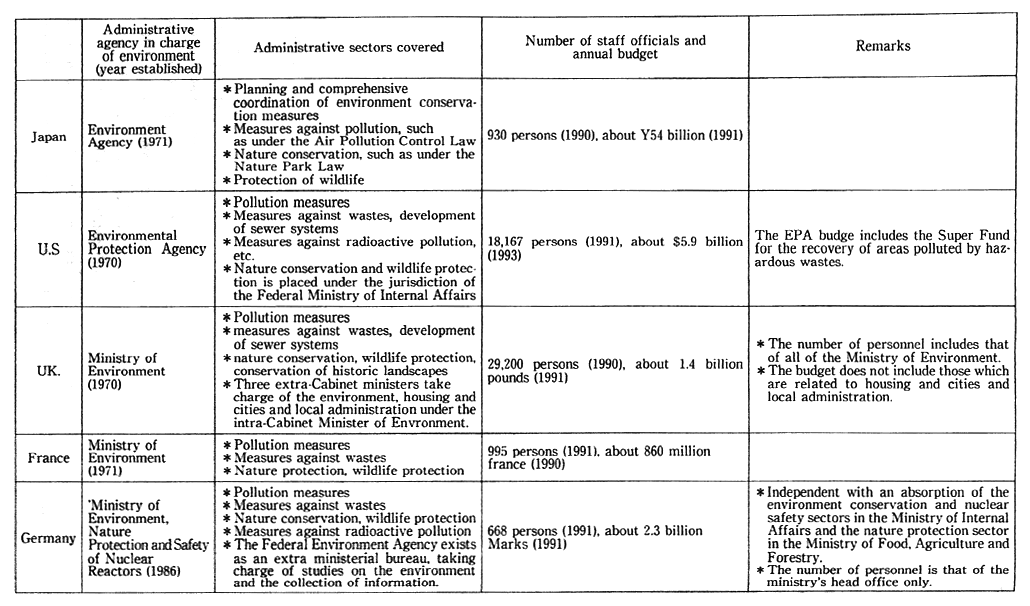
With such developments in the background, the Environment Agency was established at the national cabinet level in July 1971, and mandated with effective implementation of governmental and adminis-trative efforts in the realm of environmental protection. The Environ-ment Agency was mandated with the following tasks:
-To plan, draw up and promote basic policies for environmental problem solving overall, including both prevention of environmen-tal pollution and protection and conservation of nature;
-To coordinate the policies of various ministries in making budget estimates of environmental measures, and to carry out overall coordination of administrative work related to protection of the environment; and
-To carry out the administrative work related to enforcement of the "Basic Law for Environmental Pollution Control", "Air Pollution Control Law", "Natural Parks Law", and various other laws in an integrated manner, and to be in charge of some parts of the work and programs related to natural parks (Table 2-3-3).
The work of developing and consolidating the level framework related to the environment made more progress after the establishment of the Environment Agency. These new laws include: the Nature Conservation Law, revision of the Air Pollution Control Law, etc. (introduction of the system of liability for no fault compensation), Pollution-related Health Damage Compensation Law (later revised to Law on Pollution-related Health Damage Compensation and Prevention in 1987), Vibration Regulation Law, Law Concerning Special Measures for Conservation of the Environment of the Seto Inland Sea, Law Concerning Special Measures for Protecting Lake Water Quality, Law for Regulation etc., of the Transfer of Endangered Species of Wild Fauna and Flora, Law concerning Protection of Ozone Layer Through Control of Designated Substances, etc., Law Concerning Prevention of Dust from Studded Tires, and Law for Promotion of utilization of recyclable resources.
It was recognized that clarification of the causes for the genera-tion of environmental problems and investigation and research on the development of effective preventive technologies, etc., formed an indis-pensable aspect of the foundation of government-administrative work for the environment. As a result, it was decided that all of the experi-ment and research expenses related to prevention of environmental pollution, etc., which were carried out at national testing and research institutes, would be budgeted and accounted for in an integrated way by the Environment Agency, which would then distribute the funds to various organs. In March 1974, the National Institute for Environmental Studies was established as an overall research center for carrying out research work on problems related to the environment.
Table. 2-3-3 Outline of Transfer of Powers from Related Ministries and Agencies at Time of Environment agency's Establishment
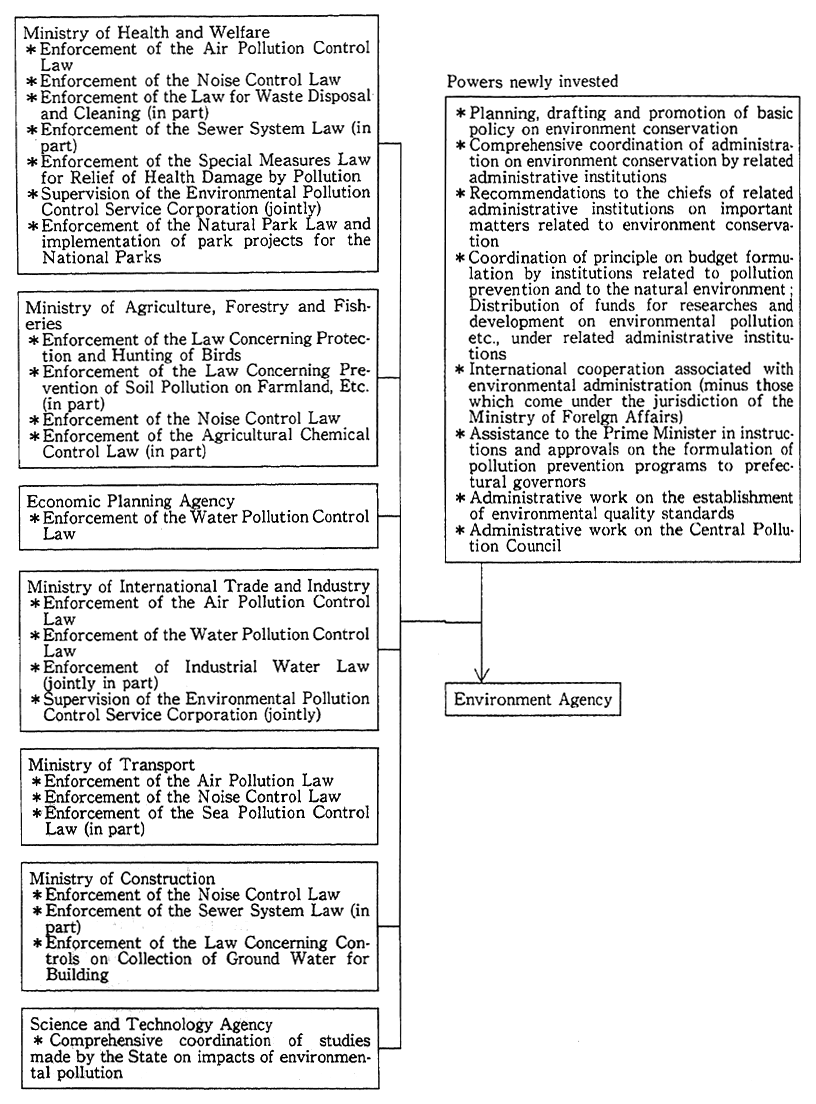
Source: Environment Agency
Even after the establishment of the Environment Agency, efforts to strengthen the organizational framework continued so as to be able to grapple with environmental problems even more effectively. Espe-cially in recent years, the need to tackle global environmental problems has become urgent, and Japan faced the task of strengthening its efforts as a country. In 1989, the Director-General of the Environment Agency was appointed as the minister of state in charge of global environmental issues with the responsibility for coordinating the administrative work related to global environmental problems under the jurisdiction of all ministries and agencies. In 1990, a global environment department was established in the Environment Agency. Related ministries and agencies have been strengthening their organizational capacity to actively cope with environmental issues, especially global environmental issues.
Also, with regard to the National Institute for Environmental Studies (NIES), the field of nature protection was added as a research area in addition to the conventioned field of environmental pollution, and the NIES was reorganized with the aim of strengthening the research organization for both global and regional environments. And in October 1990, the "Center for Global Environment Research" was established as the nucleus body for global environment studies as well as monitoring. In the Meteorological Agency, the "Center for Global Warming Information" was established in 1990 as a global information center of Green House Gases according to the request of the World Meteorological Organization (WMO), In the Agency of Industrial Sci-ence and Technology, the Institute for Pollution and Resources will be reorganized to the Institute for Integral Science and Technology on Resources and Environment. The capacity of Study on science and technology are being strengthening now.
(2) Building environmental consideration into local governments' administrative work
Local governments of different levels have been stepping up their work with environment problems as well. Problems of the environment were grasped first and foremost as problems for regional and local communities. And precisely because the problem of environmental pollution was experienced as a problem of local nature with serious or even devastating consequences by the people in the local communities. from early years on, local governments found themselves as the targets of criticisms arid protest movements by the residents of affected areas. For this reason, many of them began to face environmental problems, and worked to find solutions on their own even before the national governments measures were implemented.
As early as 1949, the Tokyo Metropolitan Government estab-lished the "Ordinance to Prevent and Control Factory Pollution", and a large number of local governments enacted ordinances to prevent and control pollution. Most of these local ordinances centered around proce-dures for construction permits of plants that might produce air and/or water pollution. Initially, it was quite difficult to implement emission control by quantitative standards. However, considering that laws aimed directly at controlling environmental pollution were adopted nationally only in the late 1950's and 1960's, these ordinances were quite significant as forerunners in the area of environmental pollution control, and they exerted a positive impact on the policies and measures adopted by the national government. Later, as the problem of environmental pollution intensified and became more widespread, a number of local governments became the first to adopt advanced policy measures for reducing the total volume of pollutants in their areas. By now, ordi-nances on environmental pollution control have been adopted in all of Japan's 47 prefectures.
Creativity and ingenuity were exercised to deal with some envi-ronmental pollution outside the bounds of environmental pollution control ordinances. One such innovation was the method of having a local community conclude an environmental pollution control agree-ment with a business enterprise (or group of business enterprises). This method has taken root throughout Japan as a way of supplementing the laws and local ordinances with detailed and supplementary stipulations
As for emission standards set in national laws which were slower in coming than local regulations, they took into account the fact that the specific situation related to the environmental problem differed from one prefecture or area to another. And so, while the laws set the uniform minimum emission standards for the country as a whole, the prefectures were given the option of applying "uwanose kijun" (more stringent standards) as needed and to establish "yokodashi kijun" (standards expanding the object of regulation) to types of facilities that are not controlled by the laws. For example, such standards (based upon Article 4 of the Air Pollution Control Law) have been set by 21 prefectures, and more stringet effluent standards (based upon Article 3 of the Water Pollution Control Law) have been set in all prefectures.
In environmental pollution control work, assessments of the effectiveness of control must be carried out, and monitoring and measurement must be done at the pollutant's source and controls must be implemented. These works comprise a system which forms the foundation of the government-administrative work for the environment overall. So, these types of administrative work were delegated from the national government to the prefectures and special designated large cities, which gave the basis for environment administration departments in local governments to exercise powerful authority based upon law, which is an important point. Through this appropriate tieup and coordi-nation between the national government and local governments, it has been possible to implement measures that are responsive to the specific characteristics of different areas, and we can say that this has been an important factor in improving Japan's situation with environmental pollution relatively rapidly.
In the area of nature conservation, efforts to establish prefectural ordinances for the protection of nature were pushed forward, seeing that the natural environment was being destroyed rapidly in Japan. The ordinance for nature conservation was first established in Hokkaido in 1970. and discussions began to establish such ordinances in most of the remaining prefectures, and by March 1972, such nature conservation ordinances were enacted in 22 out of 47 prefectures. These ordinances for nature conservation can be classified broadly into three categories. The first type can be described as the "basic ordinance on nature conservation" which sets the prefecture's measures and responsibilities for nature conservation and provides for the setting up of a "nature conservation advisory council" and other basic items related to nature conservation. The second type can be described as the "roads landscap-ing and beautification ordinance", which aimed at developing scenic beauty for national and prefectural roads. The third type can be de-scribed as the "nature conservation ordinance" the narrow sense of the term, which stipulates basic items related to nature conservation, identifies the areas that need to be protected and conserved based upon special necessity, and set up a permit or notice system for specific types of activities within the designated areas.
There arose a question as to whether or net restrictions on land uses by citizens can be made by these ordinances that adopt such a permit system without some specific basis in national law. In order to resolve this kind of a problem, establishment of a founding type of law became really urgent, and this served as a motivating force for the establishment of the Nature Conservation w in June 1972. This Nature Conservation Law has a dual character: It serves as a basic law concerning nature conservation, on one hand, and it also has the charac-ter of an enforcement type law in that it provides for designation of specific nature conservation areas. With regard to the former part, the basic ideals and the responsibility of the local governments are made clear. And with regard to the latter aspect of the law, there are funda-mental stipulations related to prefectural nature conservation areas and the prefectural nature conservation advisory council. In addition, these provisions serve as the foundation of control measures such as restric-tions on land use by citizens in the nature conservation areas designated in the prefectural ordinances. Carrying forward the intent of the nature conservation ordinances that were already enacted in many prefectures, it stipulated that such ordinances were to be enacted in all prefectures. In nature conservation, work ranges from protection of truly outstand-ing examples which represent Japan's nature, to conservation and positive use of natural areas closer to communities. Here, too, parts of executing powers based upon the Nature Conservation Law, like the Natural Parks Law and the Wildlife Protection and Hunting Law, belong to the prefecture, or the actual work is delegated. And the Basic Survey on Natural Environment Conversation which is based upon the Nature Conservation Law is also implemented with the cooperation of the prefectures. Thus, varied measures for nature conservation are carried out through partnership and linkage between the national government and local governments.
Local government's administrative organization for environmen-tal work was improved as well. As environmental problems deteriorated and became more urgent, the number of local government employees engaged in environment-related work increased (Fig. 2-3-1). Also, with regard to the units in the local governments' organization for dealing with pollution, there were initially large numbers units engaged in planning and development of projects, and gradually, specialized units and departments were established in some areas (Table 2-3-4). Also, organs and agencies carrying out research and tests related to pollution problems were set up one after another, and in the latter part of the 1970's, major cities in all the prefectures as well as the specially designated large cities established pollution research organs. These developments were aimed at strengthening of response to escalating environmental problems. However, as models and patterns were set for many of the environmental pollution problems in the late197O's and early 1980's, the number of personnel engaged in environmental protec-tion work began to level off and then decline slowly, and in the organi-zational realm, there are moves to consolidate specialized environment-related departments with public health departments, etc. On the other hand, there have been local governments that have newly set up organi-zation units to deal with global environmental problems. Some of them are starting to incorporate problems related to local environment and nature conservation in local environmental pollution studies institutes.
Fig. 2-3-1 Trends in Number of Staff Officials (Full-Time) in Charge of Pollution at Local Governments
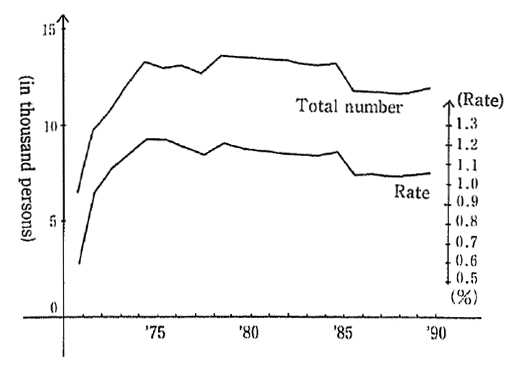
Source: Environment Agency
Table 2-3-4 Organizational Trends in Bureaus/Departments in Charge of Environment
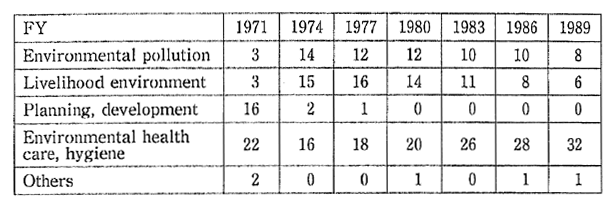
Source: Environment Agency
Note: As of October 1 for each fiscal year (July 15 for FY1971).
In thin way, the organizational framework for promoting govern-ment's work for environmental protection has been developed, and the national government and local governments have worked closely to strengthen controls, to monitor pollutant sources, and provide guidance, and to enforce the laws and ordinances. The transition in the budgets of the national and local governments related to environmental protec-tion is shown in the appended figures (Fig. 2-3-2 and Fig. 2-3-3).
Fig, 2-3-2 Budgetary Amounts for Environment Conservation and Its Share in National Budget
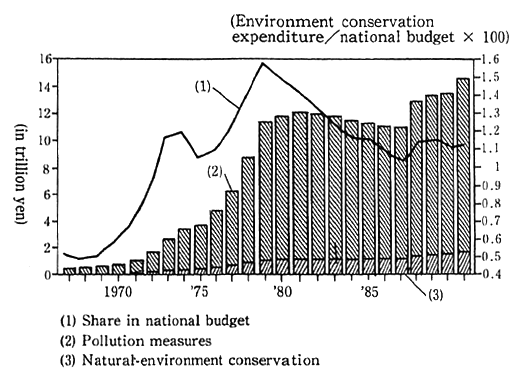
Source: Environment Agency
Fig. 2-3-3 Local Governments' Expenditure for Pollution Measures and Its Share in Total Amount of Settlement
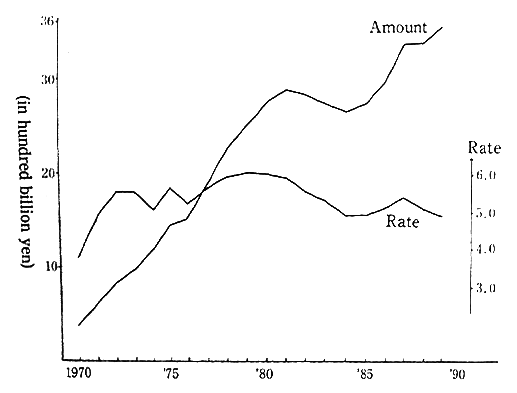
Source: Ministry of Home Affairs
(3) Environmental Consideration in concrete policies and measures
Along with changes in the character of environmental problems, the content on policy means related to environment protection have become highly diverse, as well as reinforced and improved.
[1] Making the goals of environmental administration clear
In order to protect the environment effectively, it is desirable to clarify the resulting environmental quality that we will be aiming to realize. To this end, in Japan, environmental quality standards are set on the basis of the Basic Law for Environmental Pollution Control. Specific quality standards have been set for five pollutants including sulfur dioxide, general environmental noise, automobile traffic noise, aircraft noise, Shinkansen (Bullet Train) railway noise, 9 types of toxic substances (including mercury in water areas for public use), 5 types of substances that pollute and undermine the life environment including organic substances shown in BOD, and 10 types of harmful substances that relate to soil pollution and contamination. Environmental quality standards express those desirable environmental quality levels. While these quality standards do not lead immediately to compulsory reduc-tion in pollution and contamination, they have proved useful in govern-ment administrative work, in helping to devise and combine a broad range of policies and measures, and for implementing a clear and appropriate allocation of roles among a wide range of concerned parties.
[2] Reinforcement and improvement of controls over polluting activities, etc.
a. Improvement and reinforcement of controls over polluting activities, etc.
Emission control is the most direct means for reducing polluting substances, and the specific controls are established on the basis of the Air Pollution Control Law, Water Pollution Control Law, etc. At present, emission standards expressed in quantitative figures have been set for 36 substances that are emitted from smokestacks and effluent outlets. These emission standards set limits on emission activity are periodically revised in a flexible manner, in response to the level of pollution, as well as the progress in technologies developed to deal with pollution. These controls have been strengthened and expanded periodi-cally.
As an example, let us look at the measures taken for nitrogen oxides. Nitrogen oxides are generated during combustion, and the pollution sources include not only stationary sources such as plants, but also mobile sources such as trucks and passenger vehicles, and these form a significant ratio of the total. As economic activities in Japan expanded and became more sophisticated, there arose an increasing level of concern about air pollution by nitrogen oxides. In 1973, the environmental quality standard for nitrogen oxides was set as a goal for countermeasures (which was revised in 1978). Based upon this, the emission standard for factories was set, and in subsequent years, the standard was strengthened and the categories of facilities subject to control were expanded. With regard to automobiles, the emission stan-dard was set in 1976. Later on, the pollutants subject to control for each automobile, and the types of vehicles covered were expanded and the standards are strengthened. (Fig. 2-3-4).
Fig. 2-3-4 Changes in Emission Regulation (regula-tions on nitrogen oxides from boilers with gas exclusively used as fuel)
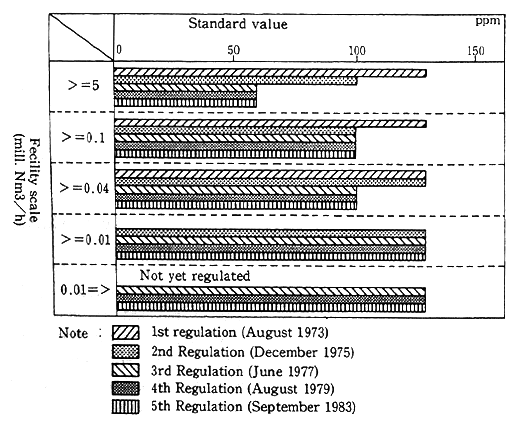
However, if emission controls exist just for individual pollution sources, then as the numbers of sources increase through expansion of economic activities, then, securing achievement of environmental qual-ity standards becomes difficult. For this reason, the system of areawide pollutant load control was introduced for applying the Air Pollution Law and Water Pollution Laws, etc., in areas where a large number of factories and business establishments are concentrated. With regard to nitrogen oxides, this system was imposed in 1981 on stationary pollution sources such as factories in the Special Wards of Tokyo, Yokohama City, and Osaka City. With regard to automobiles, because the cause lies in the increase in traffic volume, basic measures that needed to be taken included policies and measures for building urban structures that do not depend upon automobiles excessively. To this end, new draft legislation entitled the "Law on Special Measures Concerning Reduction of Are-awide Load of Automobile Emissions such as Nitrogen Oxides, etc. in Designated Areas" was presented to the 123rd session of the National Diet in 1992.
Also, with regard to water pollution control measures, work initially started with strengthening of regulations on concentration levels in effluent from individual sources such as factories and business establishments. however, in closed water areas such as harbors, inland seas, and lakes and ponds, etc., it is essential to reduce the total pollution load. Therefore, through the revision of the Water Pollution Control Law and the Law Concerning Special Measures f or Conserva-tion of the Environment of the Seto Inland Sea, a system for controlling the pollution load was introduced for Tokyo Bay, Ise Bay, and the Seto Inland Sea. In the course of three stages of control, measures to control and reduce the pollution loads for both living environment pollutants and industrial pollutants were implemented in 1979. For lakes and recevoirs, there was some deterioration in water quality so that the environmental quality standards could not be met, and it was ascer-tained that the causes lay not just in factories and business establish-ments, but also in a diverse range of other sources such households and agriculture and live stock raising activities. In order to promote mea-sures that covered these sources, the "Law Concerning Special Mea-sures for Conservation of Lake Water Quality was established in 1984. Under this law, the lakes and recevoirs are designated for which it is urgent to secure environmental quality standards, and a lake and recevoirs water quality conservation plan is formulated. With this plan as the basis, various types of projects and controls over different types of pollution sources that contribute to the protection of water quality are drawn up and promoted in an overall and planned manner, such as development of sewage systems, and measures to conserve the natural environment around the lakeshore.
In recent years, household effluent has become one of the major causes for water pollution. In 1990 in order to implement measures to deal with that, the Water Pollution Control Law was partly revised, and the responsibility of the government and citizens related to measures for household effluent were clarified. Regulations concerning household effluent were stipulated covering designation of priority areas by prefec-tures, and plans were drawn to promote measures to reduce household effluents by the concerned municipalities. We will show one example of Kanra Town, Gunma Prefecture, which was the first community to be designated as a priority area for measures to deal with household effluent. We present here the planning chart which shows the system of measures developed by the town to deal with household effluent, and how the town is planning to develop and improve various facilities to reduce the load of pollution (Fig. 2-3-5 and Fig. 2-3-6).
Fig. 2-3-5 Chart of System and Planning for Household Waste Water Measures in Kanra Town
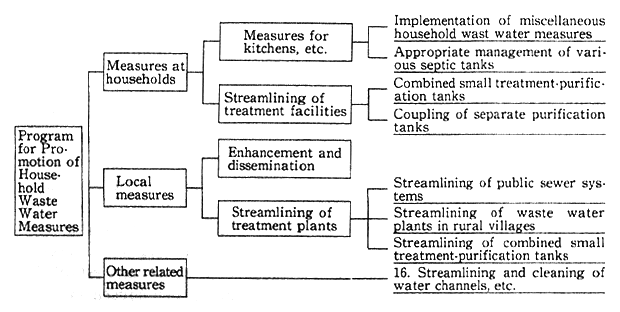
In this way, when we look at reducing polluting substances, it starts with control of individual pollution sources. When necessary, areawide pollution load control systems are used in which total emis-sions are reduced from various types of pollution sources that exist within a specific area, development which combines social infrastructur-e (such as improvement of sewage), and measures related to land use, etc. In the course of such development, the content of the policies and measures become more diversified so as to facilitate this multi-dimensional approach.
Fig. 2-3-6 Illustrated Plan for Promotion of Household Waste Water Measures in Kanra Town
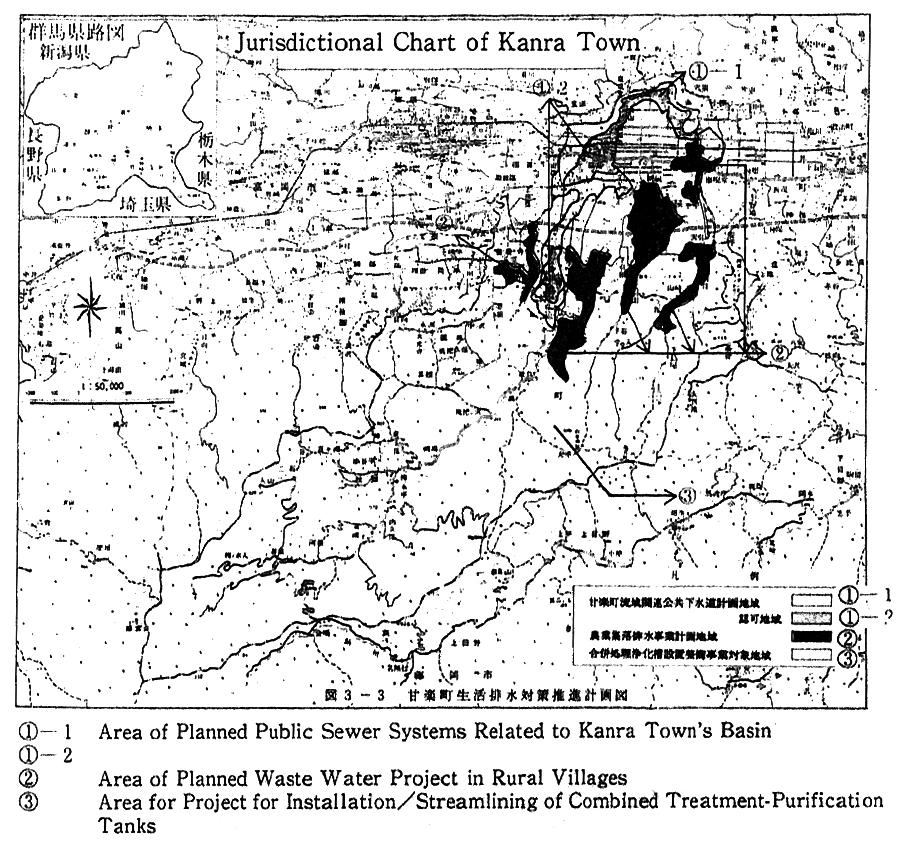
Source : Kanra Town Household Waste Water Measure Promotion Program
Work does not stop with measures that just focus on emission outlets as a measure to reduce pollutants. Rather, some of them give consideration to the process that led to the occurrence of the problem. These measures are expanding to include such measures as controlling the sulfur content in the fuel that is used in the process, structural controls related to dust which seek to make the production equipment itself contribute to prevention of leaks, control over the production of chemicals for which diverse forms of emission are conceivable, and prohibition of manufacture, sale and use of products such as studded tires which are likely to give rise to harmful environmental impacts. Also, more recently, such measures are broadening out to include guidance to encourage use of renewable resources for recycling, con-trols over production of specific types of chlorofluorocarbons (CFCs) and control of their emissions, etc.
Now, the control measures that we have examined thus far have been aimed mainly to control and prevent temporary environment pollution, but there are some controls that are aimed at preventing more cumulative types of contamination that are more directly linked to sustainability. The fact that these measures are increasing and develop-ing is important. For example, there are controls such as control of manufacture and use of chemical substances such as PCBs, controls to prevent soil pollution and establishing environmental quality standards related to soil contamination, control of pollution loads for lakes where contamination and pollutants tend to accumulate more easily, areawide pollutant load control for closed coastal water areas, and controls to prevent contamination of underground water. And even though it is not a form of legal control, there is monitoring and measurement for the residual levels of cumulative impact of acid rain and chemical sub-stances in the environment.
In addition, in recent years, a number of measures are beginning from the perspective of protecting the global environment. In order to implement Japan's measures to deal with global warming in a planned and comprehensive way, the "Action Program to Arrest Global Warm-ing" was adopted in 1990: and controls over emission of CFC are part of this effort.
b. Improvement of measures for protection of natural environment such as controls over activities that change nature
The natural environment must be protected with our eyes focused on its value as a resource.
Through the establishment of the Environment Agency, it came to have authority related to administration for nature conservation in nature parks, national gardens, administration over hot springs, and administration over wildlife. Previous laws related to nature conserva-tion each addressed diverse and wide-ranging nature from very limited aspects. For example, the Natural Parks Law was aimed at protection of scenic areas, and the Wildlife Protection and Hunting Law aimed at protection of wildlife. So, in order to develop the basic principles to coordinate the application of these individual laws in an overall way, the "Nature Conservation Law" was enacted in 1972 setting a clear basic direction for conservation of the natural environment for the whole country. Along with this, the Natural Parks Law was revised a well. As for separate and individual measures, the Basic Survey on Natural Environment Conservation was carried out to gather basic data on natural environments; nature conservation areas were designated with the aim of protecting of the natural environment; and control over activities in natural park areas were strengthened further.
Basically, all of these activities were focused on designated area with especially rich natural environments, and sought to conserve nature by controlling human activities within the designated areas. At the same time, the voices that asked for increased access to nature increased. Under this kind of a situation, it was recognized in re and more that it was not sufficient to take measures to control and hold off development, for it is indispensable to actively secure and create spaces and opportunities for access and interaction with nature, so as to nurture the spirit and heart of loving and caring for at neture. For this reason, after around 1975 or so, work began to build various types of facilities for natural parks o as to increase interaction with nature and to promote education about nature. In addition, whole range of new facilities were established such a the "People's Outdoor Racreation Areas in Natural Parks" and "Nature Observation Forest,"
Also with regard to the protection f fauna a flora, the first step in Japan was to institute control measures such as setting up of wildlife protection areas, etc. so as to strengthen management and protection of wildlife. Now, international moves are afoot to protect not just wildlife, but fauna and flora overall through the adoption of the "Convention on International Trade in Endangered Species of Wild Fauna and Flora" (the Washington Convention CITES) in 1973. There-fore, efforts were made to build the organizational framework for its implementation and to develop the legal system in Japa to include controls of trade and commercial transactions. For example, bilateral agreements and treaties were signed for protection of migratory bird starting with the agreement between Japan and the United States in 1972, and a system was built for faciltating international cooperation for the protection of migratory birds and other dangered bird. In 1972, the "Law Concerning the Control of Thansfer of Birds in Danger of Extinction" was established, and in 1987, the" Law for the Regulation etc., of the Transfer of Endangered Wild Fauna and Flora" was enacted in order to contrl trade in species covered by the CITES within Japan. In particular the Kushiro Wetlands, Izu Marsh, Kussharo Lake and Utonai Lake were registered as designated areas under the stipulation of the treaty on internationally important wetlands ("Convention on Wetlands of International Importance, Especially as Waterfowl Hab-itat" or Ramsar Convention), and efforts are being made to ensure their protection and correct use. Furthermore, with regard to "kasumi-ami" type fowling nets for which use had already been prohibited, sales and possession, too, were banned, in order to ensure thoroughgoing protec-tion of wild birds. In addition, surveys were carried out on the endan-gered species to prepare the basic data for implementing protection measures, and as a result, the Japanese version of "the Red Data Book" has been produced. And the work of protecting and breeding endangered species such as the Iriomote wild cat, the Japanese crested ibis, and "shimafukurou" (Blakiston's fish-owl) has continued.
We see, then, that in the area of nature conservation, there has been a broadening range of policy measures developed including direct control over activities that change or deform nature, and linkage with various types of development programs and projects. Also, a number of significant steps are being taken from a global perspective.
[3] Assistance for projects, facilities and development of technologies that contribute to environmental protection
In addition to control-type measures such as emission controls and restriction of activities that alter nature, the government has promoted development of technologies contributing to pollution preven-tion and energy conservation. The government has also taken measures to provide financial assistance and subsidies for the construction of specific types of facilities to promote activities that benefit environmen-tal protection. Additionally, the government promotes activities to ensure speedy and smooth implementation of control measures, with limited scone in accordance with the Polluter Pays Principle. These include specical tax meas es such as cost depreciation of facilities to prevent and control environmental pollution, loans by the Japan Envi-ronmental Corporation, programs to build and transfer facilities, and ba extended by the Japan Development Bank and Smaller Business Finance Corporation.
In the field of nature conservation tax preferential treatment is given for donations to non-profit foundations which manage "national trust" with a view to expanding participation of a broad strata of people in Japan.
[4] Promotion of public works that contribute to environmental protection
Public works that contribute to environmental protection are overseen by many ministries and government agencies (Fig. 2-3-7). For example, the Ministry of Construction builds green buffer zone develop-ment projects to prevent and hold down air pollution and sewage development projects to protect water quality. The Ministry of Health and Welfare funds community waste treatment plants and domestic treatment systems for household waste water, and the Ministry of Agriculture, Forestry, and Fisheries funds agricultural communities drainage facilities development projects, etc. Special improvement projects for removal of polluted agricultural soil are carried out by the Ministry of Agriculture, Forestry and Fisheries, waste disposal facility construction programs are supervised by the Ministry of Health and Welfare and projects for harbor facilities are overseen by the Ministry of Transport. Projects for improvement of road structures and roadside environments, and construction of loop bypass roads are carried out with regard to road traffic pollution measure (Ministry of Construction), projects for proper location of cargo facilities (Ministry of International Trade and Industry, Ministry of Transport, and Ministry of Construc-tion), and subsidies for low-pollution cars (Environment Agency, Minis-try of International Trade and Industry, Ministry of Transport), etc., and with regard to aircraft noise measures, projects to prevent noise around public airports (Ministry of Transport), and projects to prevent noise near defense bases (Defense Facilities Administration Agency).
Fig. 2-3-7 Trends in Main Environment-Related Pub-lic Works Projects Expenditure
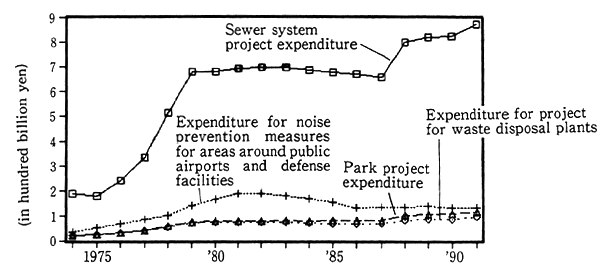
Source Environment Agency
With regard to protection of natural environments, the Environ-ment Agency carries out programs to develop facilities within natural parks, purchase of private land by government within parks, develop-ment of facilities for nature education outside of parks, protection and breeding of wild fauna and flora that are in danger of extinction, and the Ministry of Agriculture, Forestry and Fisheries supervises programs to develop and manage protection forests, and projects for construction of multipurpose rivers.
In this way, a broad range of public works projects are being carried out for environmental protection and conservation by various ministries and agencies. In order to promote these wide-ranging projects efficiently, the Environment Agency coordinates the policy for making estimates of costs required for environmental protection in advance of budgetary requests by concerned ministries, brings together the expendi-tures for environmental protection based upon such policy, and then makes budgetary requests.
Based upon the Basic Law for Environmental Pollution Control, "regional pollution control programs" are formulated in those areas where pollution is especially severe, so as to devise measures for environment protection, and various types of programs that are related to these measures, in an overall and planned manner. Such regional pollution control programs have been established in 36 regions. Of the public works projects based upon these plans, with regard to programs for improvement of waste disposal facilities and programs for develop-ment of green buffer zones, special measures such as subsidies by the national government or increased subsidy rates are applied based upon the ""aw Concerning Special Government Financial Measures for Pollution Control Projects", and programs are carried out on this basis.
[5] Incorporating environmental considerations into other public projects
Controlling emission of pollutants into the environment using emission regulations is important, but the nature of environmental pollution is such that once it occurs, it is difficult to recover. In order to ensure environmental protection, it is essential to prevent environmen-tal pollution from occurring. Environmental impact assessment is an effective means for this. When we look at international trends, environ-mental impact assessment was first established in the United States in 1969 in the "National Environmental Policy Act". Based upon this, environmental impact assessment was made mandatory for any recom-mendation, bill or any other important action by the U. S. federal government which may have an important impact on the environment. This was followed by enactment of laws on environmental impact assessment in France, Sweden and other countries. In the EC, "the EC Committee's directive regarding environmental impact assessment for certain public and private projects" in 1985, made it mandatory for member countries to carry out environmental impact assessments for certain categories of projects. In Germany, based upon this directive, environmental impact assessment was made mandatory in 1989. Today, environmental impact assessment is in the process of being institutional-ized in developing countries such as Korea, China, and Thailand. (Table 2-3-5).
In Japan, environmental impact assessment began to be im-plemented widely by the government with the Cabinet understanding entitled "On environmental protection measure for various types of public projects." With this cabinet understanding the position of environ-mental impact assessment was defined more clearly in the revision of the Harbor Law and the Public Water Body Reclamation Law, other project-related laws, and in administrative guidance by government ministries and agencies. Local governments, too, based upon the cabinet understanding of 1972, were required to implement measures similar to those by the national government, and so, institutionalization of environ-mental impact assessment was carried out. However, the contents and procedures of environmental impact assessment varied from one prefec-ture to another, and the specific process for environmental impact assessment was not yet well developed, and so, there arose a need to define and set uniform procedures. For this reason, it was decided that the question of institutionalizing it as a law needed to be examined. The government drew up a draft law and presented it to the national Diet, but it did not pass. Finally, the Cabinet decision entitled "On implemen-tation of environmental impact assessment" was passed in 1984, and it was decided to carry out environmental impact assessment through an administrative measure. The Cabinet decision is the most authoritative decision making method in the executive branch, and even though it is only an administrative measure, it is significant as a new step forward in the development of environmental impact assessment. Based upon this, concrete administrative experiences have subsequently been achieved, and the record of these experiences is summed up in the appended table (Table 2-3-6).
Table 2-3-5 Outline of Projocts required Environmental Impact Assessment in Other Countries
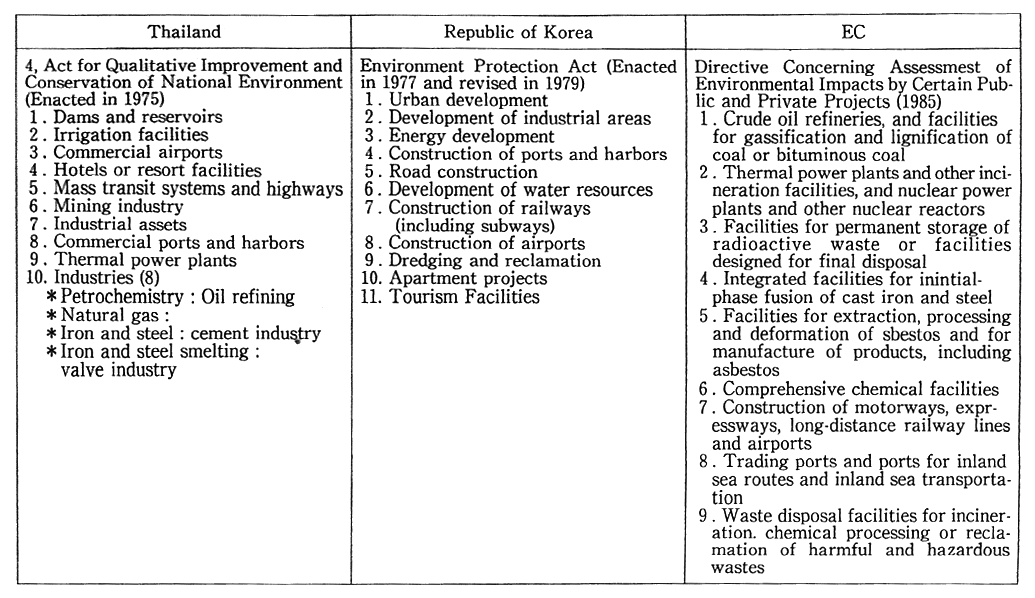
Note: 1. Surveyed by the Environment Agency 2. The scales and requirements of the subject measures are omitted in this table.
Table 2-3-6 Rates of Projects Amounts carried out Assessment under the Cabinet Decision to Total Projects Amounts by Type of Project
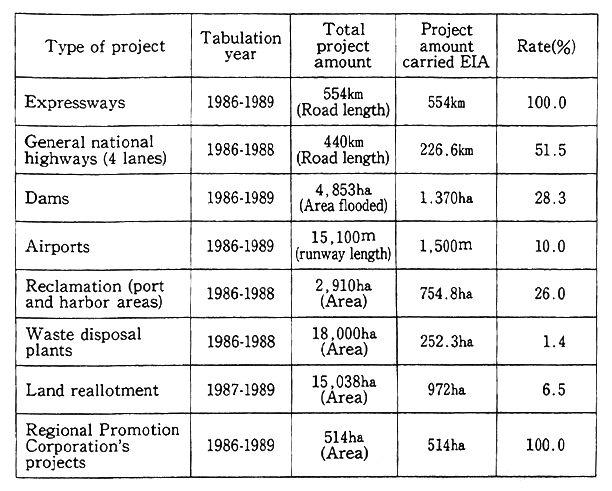
Notes :1. Methods of tabulating the total amounts of projects Tabulated in the fiscal years of upgrading to development programs: expressways Tabulated in the fiscal years in which construction was started : dam and land reallotment projects, Regional promotion Corporation's projects Tabulated in the fiscal years of initiation (construction started) : General national roads, airports, reclamation, waste disposal plants 2. Method of calculating the amounts of environmental irpactassessment-projects Tabulated in the fiscal years in which environmental impact assessment reports were filed with the Environment Agency
Sources: Roads: Annual Report of Road Statistics (1987, 1988, 1989, 1990) Dams: Dam Yearbook (1990) Airports: Aviation in Numerical Terms (1990) Reclamation: Outline of Ports and Harbors (1990) Waste disposal plants: '90 Waste Yearbook Land reallotment projects: City Planning Handbook (1987, 1988, 1989, 1990) Regional Promotion and Redevelopment Corporation's projects: Outline of Local City Development and Redevelopment Projects (1990)
Now, in addition to considering the environment at the implemen-tation stage of individual projects, it is important to build in environ-mental considerations, in the development of development policy for the country and the area as a whole before it is turned into an actual project. In this respect, the Environment Agency established "the Long-term Plan for Environmental Protection" (1986), and the National Land Agency and Environment Agency has set the "National Land Use Plan National Plan" (1985. On the regional and local level, the Environ-ment Agency has established "Guidelines for the Uses of the Environ-ment" as a model. In formulating regional land use or development plans such as the "National Land Use Plan-prefectural and municipal plan" and the "Metropolitan Area Redevelopment Plan", environmental consideration is incorporated. Also, at some local governments, "envi-ronment management plans" have been adopted in which measures are instituted not only to prevent flow-type pollution, but to raise the quality of the environment as a resource.
2-3-2 Business Efforts and Achievement
It is said that Japan's environmental protection policy has been successful.
Japan's astonishing postwar economic recovery is referred to as a "miracle," however, overcoming severe pollution problems in a short period of time without negatively impacting business operations and the entire national economy is evaluated as "another miracle of Japan" In order to clarify several reasons why this has happened, this section reviews enterprises' activities which directly contributed to pollution protection, including investments and technology developments by business enterprises, as well as the derived energy conservation and structural changes which supported environmental protection. It should be understood th t pollution protection has been promoted not merely as a natural course of economic activities but also by governmental policies ba d upon long-term strategic planning and enforcement of regulations, financial Incentive support and establishment of markets that accept low-pollution products. Thus a positive attitude by busines-ses for pollution prevention has stimulated the power of the market economy and economic growth has been made while the social economic mechanism was moving toward environmental preservation.
(1) Overcoming pollution supported by industry structure change and energy conservation triggered by two oil crises
1) Industry structure change and environment
During the evolution of industry structure, there has been a remarkable change in energy consumption and water usage which are closely related to the environment.
An economic white paper of 1972 showed an analysis of trends in pollution generation comparing Japan and West Germany. In the analy-sis, an industry structure (input/output structures) and a demand struc-ture were considered as elements of an economic structure. Production activities of various industry sectors consisting of economic activities consisted of transactions of raw materials, intermediates and final products. The relationships among these products differ by countries, however, the difference can be considered as that of industry structures (input/output structures). Patterns of personal consumption, investment in plant and equipment by the private sector, and exports are also different by countries, and this difference can be derived as that of demand structures. Under such an assumption, comparing volume of pollutants generated by production activities with that of West Ger-many, it was estimated that differences of pollutants volume originated from differences of production structure might be 10% larger than that originating from differences of demand structure. (see Fig. 2-3-8). This means that the economic reason for increases of pollution in Japan is partly due to its industry structure.
In Japan's high level economic growth, the secondary industry, (more specifically, the basic material type of industry) had played a major role in its growth. In two oil crises experienced in 1973 and 1979, jumps of oil prices considerably impacted all industries of Japan which used imported oil for 3/4 of the total energy consumption. Analyzing a relationship between production and oil consumption by industry sec-tors, it was found that both production and oil consumption largely increased in all the industry sectors until the later half of 1960's. However, since the 1970's, production in the assembling and processing industry in which energy consumption is relatively smaller has grown largely, while the growth rate of the production in the basic material industry such as metals and chemicals significantly slowed down as well as decrease of unit volume of energy consumption. In the basic mate-rials industry in which the portion of energy and material costs to total production cost is higher, production and shipment volumes dropped and the industry scale had to he squeezed and restructured due to hikes in production cost, drops in domestic demand and a relative decrease of international competitiveness. On the other hand, in the assembling and proc ing industry, typified by electronics and precision machinery, production and shipment volumes steadily increased and occupied an important place in the production industry sector, due to demand stimulated by developments of advanced technology products and a growth of exports (see Fig. 2-3-9). Such a change of production struc-ture shifting to the assembling and processing industry of higher added values and higher functionalities caused by the change of industry structure has been primarily derived from the market principle of cost reduction. This was not because of a willingness for environmental protection. As the result, the load to the environment from production as a whole has been reduced while increasing added values.
Fig. 2-3-8 Impacts on Environment of Industrial Structure (Compar-ison Between Japan and Former West Germany)
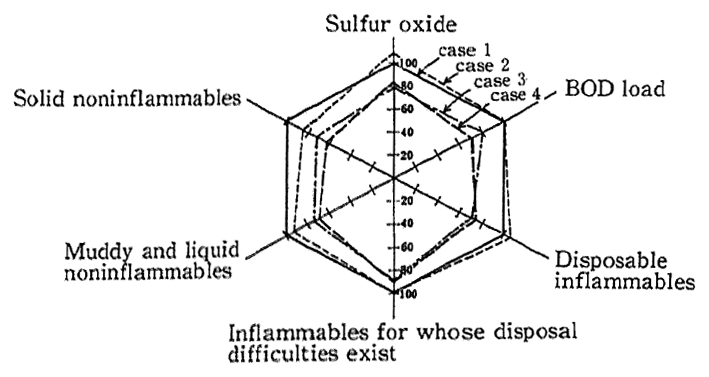
Source: Economic Councils Measurement Committee : "Projected FY 1971 Industrial Table" Economic Planning Agency : "Annual Economic Report" (1970) Ministry of International Trade and Industry "Survey on Treat-ment and Disposal of Industrial Wastes" Prepared from : Deutsches Institut fur Wirtschafsforschung: "Vier-teljarsheft 3-71"
Notes:1. Case 1: Japan's production and demand structures
2. Case 2: Former West Germany's hypothesized demand structure
3. Case 3: Former West Germany's hypothesized production Struc-ture
4. Case 4: Former West Germany's hypothesized production and dem-and structures
Fig. 2-3-9 Trend in Industry's Sector-Specific Output (indexed with Term VI of 1973 at 100)
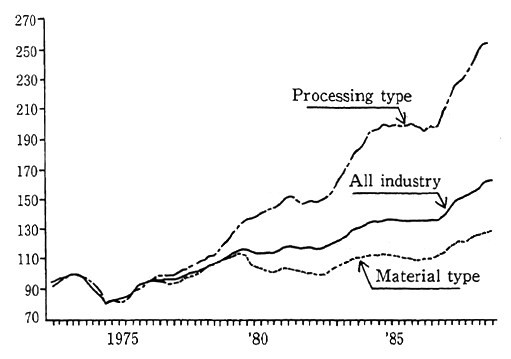
Notes: The processing types includes the general mach-inery industry, electric machinery industry, transport machinery industry and procession machinery industry. The material type includes the iron and steel industry, nonferrous industry, ceramic, earth and stone industry, chemical industry (minus medicines) and textile industry.
Source: Survey and Statistical Department, Ministry of International Trade and Industry, "Gen-eral Outline of Industry Indices" and "Year-book of Industry Indices"
2) Environmental improvement supported by increased considera-tion of energy and resource conservation
Energy and resource conservation has been practiced by industry purely as economic behavior to save production costs. It is an effective means to ease restrictions of energy and resources in a country that largely depends upon both imports and directly contributes to the production cost reduction of enterprises. Japanese enterprises made a tremendous amount of effort to conserve energy and resources triggered by two oil crises. GNP during the 14 years from 1973 to 1987, increased by a factor of 1.7 while the energy consumption level was kept almost constant. Macro scale energy productivity (production per unit volume of energy consumption) increased by a factor of 1.65 during this period. Energy productivity in the production industry increased by a factor of 1.8 which was better than that of industry as a whole in the same period.
Water usage volume significantly increased in the latter half of the 1960's, and the first half of the 1970's, has decreased its increase rate thereafter. Usage volume of fresh water includes new supply and recy-cled water. Recycled water usage in the total volume of fresh water consumption shows that 36.2% in 1965 dramatically increased to 73.9% in 1981. Along with a slower increase rate of water volume for industrial use, the supply of new water dropped since 1974 (see Fig. 2-3-10).
Fig. 2-3-10 Trends in Use of Water (Freshwater) and Recovery Rate
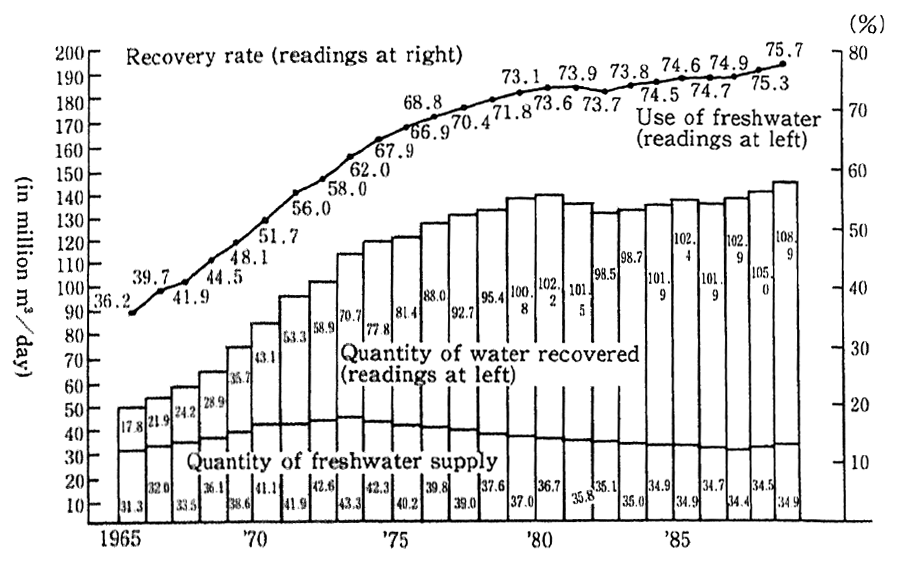
Source: prepared from the Ministry of International Trade and Industry's "Census on Manufactures"
Note: Recovery rate = quantity of water recovered/quantity of freshwater used.
The cost reduction resulted from enterprises' effort toward energy and resource conservation has strengthened their business power, increased their international competitiveness along with im-proved processing technology, and stimulated the export driving force, Thus Japanese industry was able to soon overcome the economic slump caused by the oil crises and produced a soft-landing of the economy to a route of stable economic growth.
Energy and resource conservation can reduce potential volume of generation of various types of pollutants (see Fig. 2-3-11). For example, an increase in recycled water usage results in prevention of river water volume decrease. The establishment of water management and purifica-tion systems at companies which are practicing water recycling, reduces the contamination load to the environment. The resolution of public pollution problems has been carried out as a counter measure to cope with the oil crises. Amplified investment needs of enterprises in the short-term and tackling energy and resource conservation throughout the whole industries largely contributed to "environmental protection", though the initial motivation itself were not directly related to the final outcome. In the process of overcoming pollution problems, some of the measures were economically justifiable. It is important to note that policies and actions to be taken for pollution prevention must be consid-ered along with other related aspects.
Fig. 2-3-11 Discharges of Sulfur Dioxides and Analysis of Contribution of Their Changes
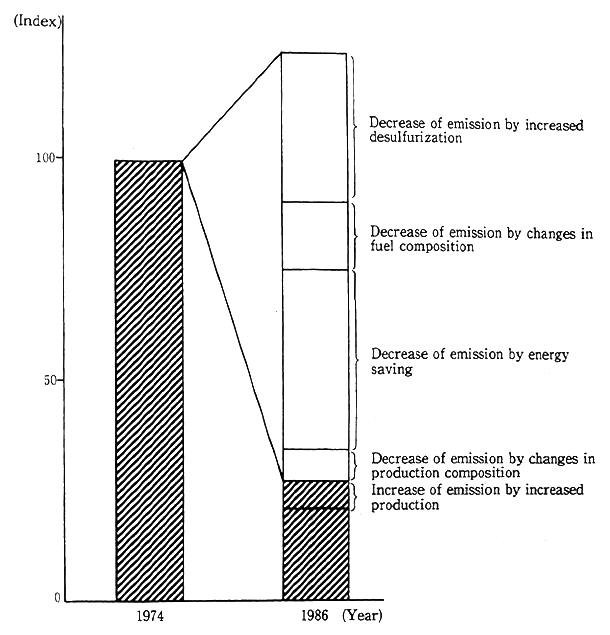
Notes: 1. Prepared by the Environment Agency
2. The indices: emission amount in 1974 =100.
Energy prices have come down since 1983 and the actual market prices in 1990 were at the level almost comparable to that of just before the second oil crisis. Therefore, contrary to the situation where energy price hikes were the major factors to stimulate spending of capital for energy conservation, lower energy prices might induce reduced spending of capital for energy conservation and the environmental improvement effort could be jeopardized.
(2) Background of positive investment for pollution prevention
1) Comparison of the economic situation when industrial pollution problems increased, the financial situation of businesses and pollution prevention investments (Figs. 2-3-12 and 2-3-13)
In the high economic growth period of the 1960's, a high level of facility investment was made in pursuit of technology innovation and scale merit, and consumption continued to grow. During that period, the economic growth rate of Japan was unparalleled in the world. A real economic growth rate (average annual increase rate) of around 10 to 11% (more than two times of the U. S. and European industrialized countries) had been maintained until 1970. Business was financially sound and its internal reserves continued to piled up.
By the oil crisis of 1973, the price of energy jumped and the Japanese economy had to shift to a so-called "new price structure." The income corresponding to the oil price increase drained out of the country and domestic buying power was squeezed. In such a situation, price increases in an economic depression, or so-called stagflation, occurred, causing economic confusion such as hoarding and holding of goods for future sale. As a result of the total demand suppression policy which was introduced to cope with the severe economic situation, Japan experienced zero growth in 1974 and 1975 for the first time since Second World War. Thus the financial foundation of the enterprises was rapidly weakened. After 1977, the economy started to indicate a recovery trend. The economic growth rate dropped to about 5% annually which was almost half in comparison with the high economic growth period. Japan could keep a constant growth rate which was still higher than that of other industrialized countries. The GNP of Japan exceeded a trillion U. S. dollars in 1980, and the GNP per capita in 1989 was more than that of the U. S. The absolute amount of GNP is reaching that of the U. S. which is first in the world today.
Fig. 2-3-12 Indices for Comprehensive Assessment of Business Conditions
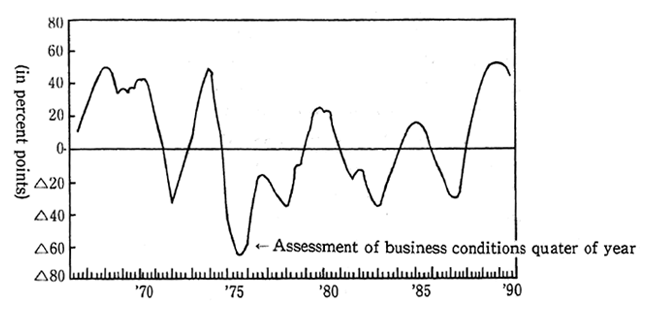
Source Bank of Japan: "Short-Term Economic Observation of Major Businesses"
Fig. 2-3-13 Rate of Current Profits from Proceeded (Manufacturing Industry)
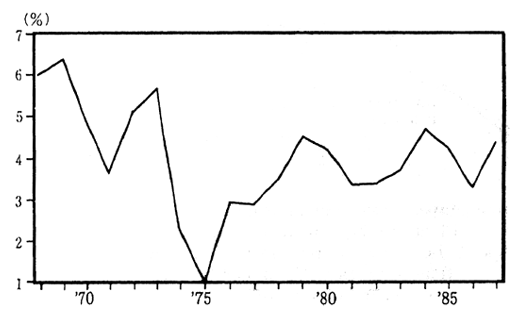
Source: Bank of Japan "Analysis of Major Busines-ses' Management"
In the process of high economic growth, Japan encountered severe pollution problems which negatively impacted economic activ-ities. However, during the early stages of high economic growth, the concern among the citizens was primarily put on economic welfare and benefits. Businesses focused their attention on the pursuit of economic efficiency and there was a lack of need and motivation to seriously consider pollution prevention measures without external factors such as governmental regulations on environmental pollution. Since the level of scientific knowledge on pollution, its influences and detection methods was poor, investment for pollution prevention stayed at a low level until the latter half of the high economic growth period.
Under depressed economic circumstances caused by the oil crisis in the fall of 1973, total facility investment amounts of enterprises dropped after 1973 until 1977. Investments for pollution prevention also decreased after the peak in 1975, but the ratio of investment amount to the total facility investment (referred to as "pollution prevention invest-ment ratio" hereafter) started to increase from the early part of the 1970's. Particularly, in the period from 1974 to 1976, the ratio stayed at a very high level around 20% each year. Compared with the level of 2 to 3% in the later half of the 1960's and in the 1980's, the ratio of 20% was outstanding while the business environment was severe. One would think that pollution prevention investment which was not directly contributing to production should have been reduced (Fig. 2-3-14).
Fig. 2-3-14 Trends in Plant and Equipment Investments and Rate of Pollution Prevention Investment (Manu-facturing Industry)
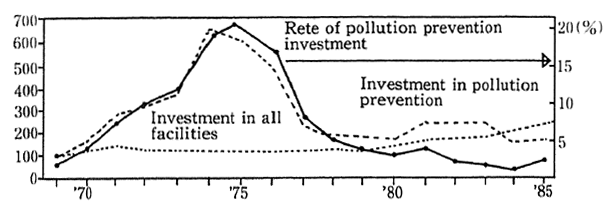
Source: Japan Development Bank "Survey on Trends of Plant and Equipment Investments"
Notes: 1. For trends in investments in all facilities and pollu-tion prevention, the amount of investment in each fiscal year is converted in terms of FY1985 prices and indexed with FY1969 at 100. 2. Rate of investment in pollution prevention = amount of investment in pollution prevention / total amount of investment
The impact on business was very severe because a large amount of the pollution prevention investment had to be spent during the economically difficult circumstance caused by the oil crisis. Japanese enterprises made an unparalleled effort in pollution prevention during the severe business environment (Table 2-3-7). This effort was directly correlated to environmental improvement. Pollution concentrations were dramatically reduced as well as the number of claims from the citizens decreased. Looking at the statistics of public pollution claims by classification of the major pollution sources, the number related to the manufacturing industry significantly decreased compared with the fig-ures of other industry sectors and the improvement result can be seen.
Table 2-3-7 Comparison of rate of Pollution prevention Investment in private sector (Japan and major OECD countries in 1974)
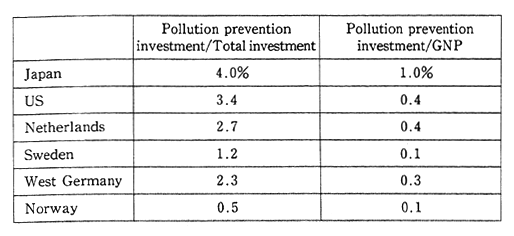
Environmental Policies Japan (OECD, 1997)
After 1975, pollution prevention investment dropped sharply. As background, it can be pointed out that the amount of new facility investment has decreased along with the lower rate of economic growth, however, the pollution prevention investment ratio is also decreasing. Air pollution prevention measures for sulfur oxides and smoke which had caused severe pollution have almost been accomplished and peak installations of crude oil desulfurization and the smoke desulfurization plants have finished.
2) Motivation for pollution prevention investment and regulation
For individual businesses, it is natural to lack willingness to install pollution prevention facilities, balancing the penalty for causing pollution or compensation for the damage with the costs of pollution prevention, since the potential social expenses (i.e., the costs to be generated outside the enterprise with the environmental destruction) are unknown. This means that, the pollution prevention investment which is not directly contributable to production can be avoided if the decision is solely dependent upon individual enterprises According to a survey of the presidents of 100 major companies conducted by NHK (Fig. 2-3-15), the majority admitted in 1970 that pollution can't be avoided. However, because of public opinion against pollution and strengthened govern-mental regulations in just two years, about 60% of them changed their opinions, indicating that pollution prevention must be promoted even while sacrificing economic growth.
Fig. 2-3-15 Entrepreneurs' Consciousness About Eco-nomic Growh and Occurrence of Pollution
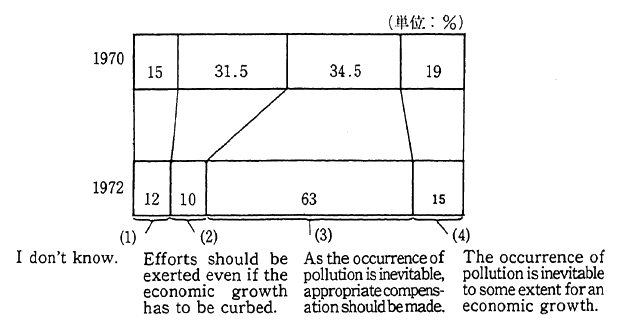
Note: Japan Broadcasting Corporation (NHK), 'Question-naire on Pollution to Presidents of Top 100 Corpora-tions in Aapanese Industry," done in June 1970 and August 1972.
The fact that external factors such as governmental regulations and guidance, and citizen complaints were a major factor in the change of business behavior has been indicated in a survey on pollution preven-tion investment motivation. For example, according to a survey of 3,000 businesses in Tokyo conducted by the Metropolitan Environmental Science Institute, external factors such as "enforced governmental regulations," "guidance of government agencies," and "claims from citizens" are motives for more than 80% of those surveyed, and it is clear that external pressure was far more influential than "willingness of businesses" in pollution prevention investment (Table 2-3-8). A similar result can be seen from the survey on "the pollution prevention invest-ment trend of small-and medium-size businesses" jointly conducted by the Environment Agency and the Small and Medium Enterprises Agency (Table 2-3-9). In addition, it can be seen that a close relationship between governmental regulations and pollution prevention investment existed when transition in regulations and investments are compared (Fig. 2-3-16).
It is true that pollution prevention investment depends upon economic circumstances, since the investment is a facility investment and it requires a fairly large amount of money. However, when facility investment and pollution prevention investment are compared, it is clear that the latter took a large portion of the entire facility investment which was staggering in the period just after the oil crises. It can be considered that governmental regulations on pollution prevention played a major role in promoting pollution prevention investment rather than putting priority consideration on business performance. From past experience, it is very important for environmental protection that a clear signal must be indicated as to how business decisions should be made.
Table 2-3-8 Motives for Installation o Facilities and Equipment for Pollution Prevention by Year
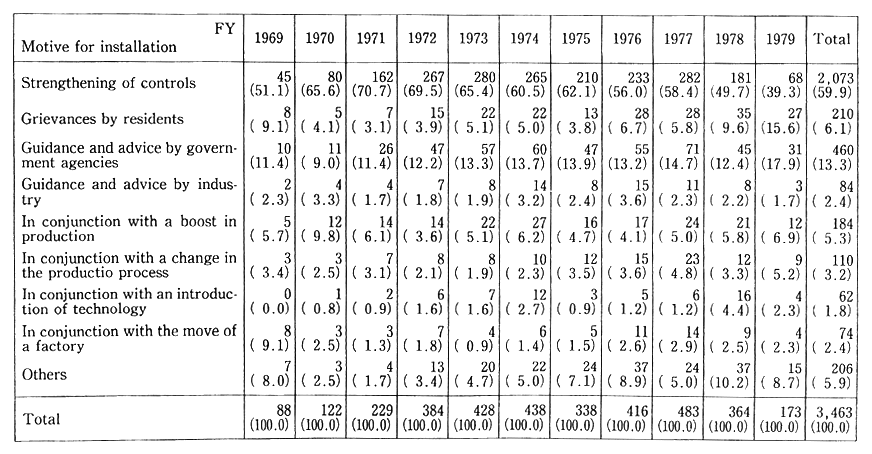
Source: Tokyo Metropolitan Environment Science Research Institute, "Questionnaire to Businesses in Tokyo (1988)".
Table 2-3-9 Motives for Investment in Pollution Prevention by Medium and Small Businesses The figures represent component rates.
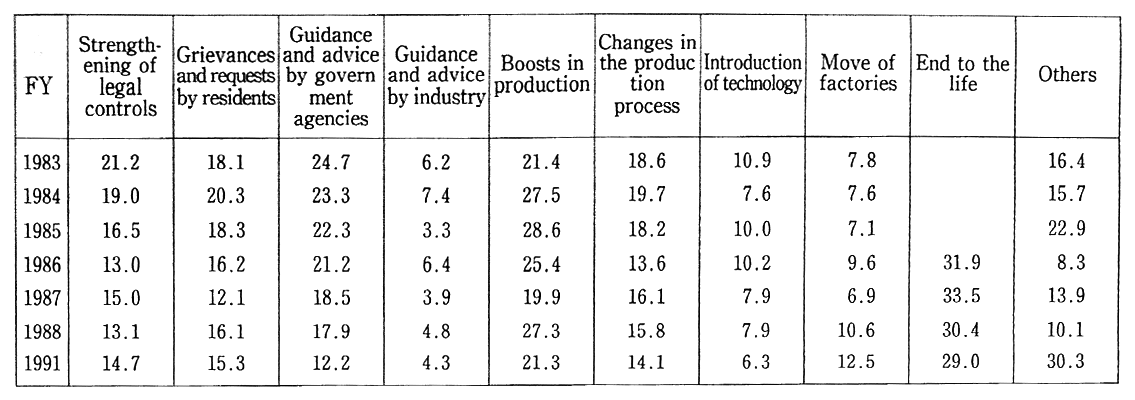
Note: Multiple replies permissible on the basis of all investment planning businesses
Source: the survey on trends in investment in pollution prevention by medium and small businesses (made by the Environment Agency and the Small and Medium Enterprises Agency).
Fig. 2-3-16 Trends in Pollution Prevention by Phenomenon and Trends in Pollution Controls (Air-Related and Water-Related)
